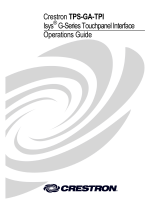
Digital Video Processor Crestron CNX-DVP4
NOTE: The Digital Visual Interface (DVI) is a digital video connectivity standard.
This standard offers two different connectors: one with 24 pins (DVI-D) that handles
digital video signals only, and one with 29 pins (DVI-I) that handles both digital and
analog video. The CNX-DVP4 uses the 29-pin DVI-I standard.
NOTE: RGB is a computer signal that uses the standard High Density (HD-15)15-
pin connector. It is comprised of three analog video signals: red, green, blue and
separate horizontal and vertical syncs. Most computer monitors use RGB (usually
called VGA, SVGA, XVGA, etc.).
G. INPUT DVI-I/RGB (4) – allows RGB or DVI video input. Input resolution from
640 x 480 to 1600 x 1200 (RGB) or 640 x 480 to 1280 x 1024 (DVI). RGB to DVI-I
adapters (4) for RGB input are supplied.
H. VIDEO INPUT 1-4 (dual BNC) – allows Composite or S-Video input. You may
have eight composite video inputs, four S-Video inputs, or some combination of the
two. Each S-Video input requires two BNC connectors, for example, if you are using
two S-Video inputs, then there are only four composite video inputs remaining.
S-Video inputs must use the same pair of A and B BNC connectors. Refer to
“Appendix C: Cable Connection Information” on page 80 for additional information.
NOTE: Composite video is a type of video signal in which all information – the red,
green, and blue (horizontal and vertical sync) signals are mixed together. This is the
most common type of signal used by video professionals.
NOTE: S-Video contains two separate components, luma and chroma (also known
as Y and C signals respectively). The luma signal contains brightness, intensity, and
signal timing information. This signal contains all picture information except for
color. The chroma signal contains only the color information. You can see the
complete black and white image, without the chroma, by only feeding the luma
signal into a monitor.
NOTE: RGBS consists of Red, Green Blue, and a Composite sync. RGBHV consists
of Red, Green, Blue, Horizontal sync and Vertical sync.
I. MEMORY EXPANSION – provides for compact flash memory card. The CNX-
DVP4 comes with a 32MB compact flash memory card (Crestron P/N COMFLS-
32M-1).
NOTE: A CNXRMCLV or CNXRMC may be added to the system for Infrared
control.
Memory
The CNX-DVP4 has 36MB of built-in memory (non-volatile and volatile). A total of
36MB is broken down as follows: 4MB flash (non-volatile), 32MB DRAM
(volatile), and 256KB NVRAM. The CNX-DVP4 ships with 32MB of compact flash
installed. Flash memory contains the file system inside the 2-series control engine.
Non-volatile memory contains information that is retained after loss of electrical
power. Volatile memory is lost after a power failure. Refer to the following lists for a
breakdown of memory usage for program-related information stored in the unit.
Refer to “Appendix A: File System” on page 76 for additional information.
Operations Guide – DOC. 8170A
10 • Digital Video Processor: CNX-DVP4





















